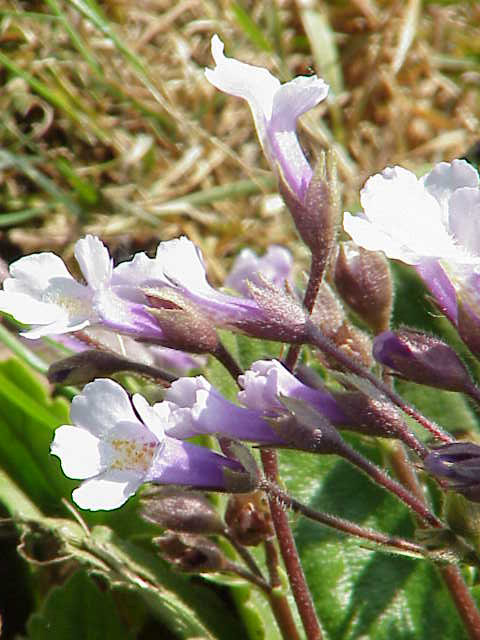- Gesneriaceae
Taxobox
name = Gesneriaceae

image_width = 240px
image_caption = "Haberlea rhodopensis "
regnum =Plantae
divisio = Magnoliophyta
classis =Magnoliopsida
ordo =Lamiales
familia = Gesneriaceae
familia_authority = Dumortier
subdivision_ranks = Genera
subdivision = See text.Gesneriaceae is a family of
flowering plant s consisting of ca. 150 genera and ca. 3200 species in theOld World andNew World tropics and subtropics, with a very small number extending to temperate areas. Many species have colorful and showy flowers and are cultivated as ornamental plants.Most species are perennial
herb s orsubshrub s but a few are woody shrubs or smalltree s. Thephyllotaxy is usually opposite and decussate, but leaves have a spiral or alternate arrangement in some groups. As with other members of theLamiales the flowers have a (usually)zygomorphic corolla whose petals are fused into a tube and there is no one character that separates a gesneriad from any other member of Lamiales. Gesneriads differ from related families of the Lamiales in having an unusual inflorescence structure, the "pair-flowered cyme", but some gesneriads lack this characteristic, and some other Lamiales (Calceolariaceae and someScrophulariaceae ) share it. The ovary can be superior, half-inferior or fully inferior, and the fruit a dry or fleshy capsule or aberry . Theseed s are always small and numerous. Gesneriaceae have traditionally been separated from Scrophulariaceae by having a unilocular rather than bilocular ovary, with parietal rather than axile placentation.On the basis of both morphological and biogeographical differences the family is divided into two major subfamilies: subfamily Cyrtandroideae in the
Old World and subfamily Gesnerioideae in theNew World . The biggest and most widespread genus is "Cyrtandra ", with about 600 species widely distributed inSoutheast Asia ,Malaysia ,Indonesia , thePhilippines , and the islands of thePacific as far away as theHawaiian Islands .Several molecular systematic studies have shown that Gesneriaceae are not closely related to any other family of the Lamiales, but more recently a sister-group relationship with Calceolariaceae has been suggested. Other studies have suggested that two genera generally placed in other families, "
Sanango " and "Peltanthera ", are more closely related to Gesneriaceae than to any other members of the Lamiales but there is as yet no consensus on whether those genera should be included in the family.The genus "
Rehmannia " has sometimes been included in Gesneriaceae but is now referred to the familyScrophulariaceae .Several genera in the family have become popular as houseplants. The most familiar members of the family to gardeners are the
African Violet s in the genus "Saintpaulia ". Gesneriads are divided culturally into three groups on the basis of whether, and how, their stems are modified into storage organs: rhizomatous,tuber ous, and "fibrous-rooted", meaning those that lack such storage structures (although all gesneriads have fibrous roots).Botanists who have made significant contributions to the systematics of the family are
George Bentham ,Robert Brown ,B.L. Burtt ,C.B. Clarke ,Olive M. Hilliard ,Joseph Dalton Hooker ,William Jackson Hooker ,Karl Fritsch ,Elmer Drew Merrill ,Harold E. Moore, Jr. ,John L. Clark ,Conrad Vernon Morton ,Henry Nicholas Ridley ,Laurence Skog ,W.T. Wang ,Anton Weber , andHans Wiehler . Several researchers are currently working on this group and the generic classification has been changing rapidly.The family name is based on the genus "Gesneria", which honors Swiss humanist
Conrad Gessner .elected genera
External links
* [http://persoon.si.edu/gesneriaceae/checklist/ World Checklist of Gesneriaceae]
* [http://www.genera-gesneriaceae.at/ Genera of Gesneriaceae]
* [http://gesneriads.ca/ Gesneriad Reference Web]
* [http://www.gesneriads.ca/Articles/Weber%20-%20Scientific%20Overview/Gesneriaceae_Article_Weber.htm Gesneriaceae: A Scientific Overview, by Prof. Anton Weber] (on the Gesneriad Reference Web)
* [http://hua.huh.harvard.edu/china/mss/volume18/GESNERIACEAE.published.pdf Gesneriaceae] in [http://flora.huh.harvard.edu/china/ Flora of China]
* [http://www.gesneriadsociety.org/ The Gesneriad Society] (formerly the American Gloxinia and Gesneriad Society)
* [http://persoon.si.edu/gesneriaceae/bibliography/ Annotated Bibliography of the Gesneriaceae]
* [http://www.amjbot.org/cgi/content/abstract/89/2/296 Phylogenetic relationships in the Gesnerioideae (Gesneriaceae) based on nrDNA ITS and cpDNA trnL-F and trnE-T spacer region sequences] (link to abstract)
* [http://www.amjbot.org/cgi/content/abstract/92/6/1017/ Evolution of Cyrtandra (Gesneriaceae) in the Pacific Ocean: the origin of a supertramp clade]
* [http://plantnet.rbgsyd.nsw.gov.au/emuwebnswlive/objects/common/webmedia.php?irn=39062&reftable=ebibliography Weber, A. 2004. Gesneriaceae and Scrophulariaceae: Robert Brown and now. "Telopea" 10(2): 543-571.]
Wikimedia Foundation. 2010.
